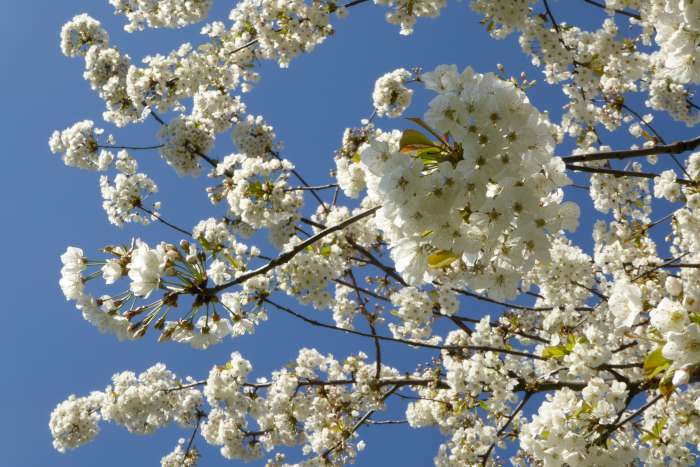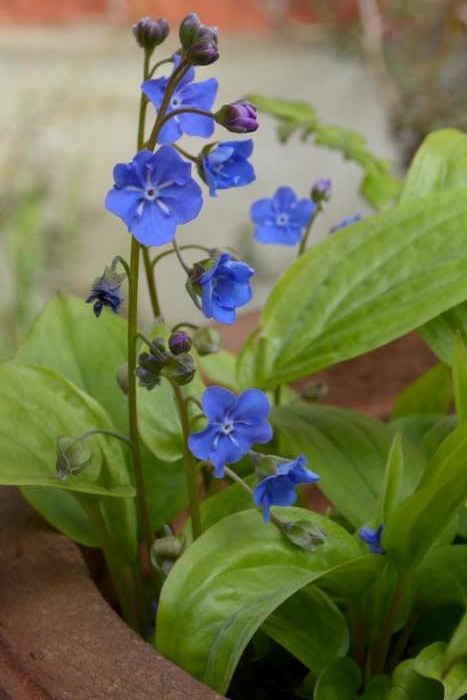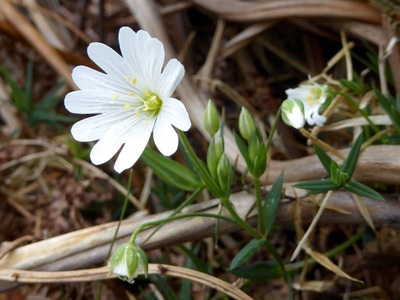And yes, it's no stretch of the imagination to link the season with a well, with fresh water bubbling from the ground. Because aren't many young shoots doing just that? And isn't the season as invigorating and life-affirming, if not to say life-giving, as a mountain spring? No doubt. But I still think the verb, the leaping and jumping, as much a name-giver as anything. The image seems so fitting: A coil released, all systems go! A sudden explosion of the vegetation after a few warm days.
Seen against a blue sky I can never keep myself from smiling as everything inside me wants to skip and sing and dance and twirl, arms outstretched, finally collapsing in a heap under these miracles humming with bees. I wish we'd do like the Japanese and celebrate it with a national holiday and picnics and whatever else this sensitive people have come up with. Cherry blossom is when spring has well and truly arrived. Everything else before feels just like a prelude.
In my own garden, suddenly there is fresh mint and lemon balm to pick for infusions. I consider my small plot entirely ornamental, but those herbs are an exception to the rule and we enjoy them never more than at this time of year. With the mint "running" (i.e. spreading via runners) and the lemon balm self-sowing everywhere, picking also helps keep them in check.
Both, however, go really well with another darling out in my garden right now: Omphalodes cappadocica. Their flowers very much resemble those of Forget-me-not’s and indeed both belong to the Boranginaceae family. I cherish both ‘Starry Eyes’ (blue stripes, like a star, on a white background that sometimes has a tinge of purplish-pink to it) and ‘Cherry Ingram’ (true deep blue of a luminious quality that is hard to find in flowers). Those cultivars, by the way, have bigger flowers than the species hence make more of an impact.
I grow both Omphalodes’ in pots, together with perennials which are slow to start - such as hostas or astrantias. That seems to work well: by the time those get going properly, the former have had a head start and begin to withdraw a little anyway. They are evergreen but in my experience benefit from a "haircut", i.e. cutting off the old leaves in late winter as you might do with Epimedium or Helleborus.
Much as I’d want Omphalodes to light up my slim rim of a border aka open ground as well, they won’t oblige. Whether they dislike the clay soil more, though it is continually improved with compost, or the competition from their neighbours I don’t know.
While Omphalodes won’t grow well in my “border”, the latter is a joy at this time of year thanks to tulips. I grow new cultivars and combinations each year, restricted however to white, pink in all shades and really dark ones. Sometimes I add orange, sometimes I go for purple. I love other colours too, of course, but have banned the “warm spectrum” from the garden because too many would fragment such a small space even further. Orange tulips sometimes escape this rule because I like lily-flowered ‘Ballerina’ so much. (And yes, there is a handful of other exceptions such as my pride and joy, the Sophora tetraptera - New Zealand’s “Kowhai” - I raised from seed.)
I treat my tulips as annuals, i.e. once they have flowered I pull them up. There wouldn't be much of a show next year anyway, thanks to the London clay which they dislike. By the time they are finished, the space is also much needed by their neighbours which get into their stride. I’d rather buy anew each autumn and have a proper show to look forward to than hope against all odds that they might bloom again. I'd also rather avoid the annoying sight of yellowing tulip leaves from which there is simply no escape in a tiny garden. The upside of having a pocket-sized plot of course is that buying new bulbs each year remains affordable.
This spring I can just enjoy them. Why not before? Well, after a handful bloomed a few years ago, I decided I really liked them and wanted to add some more bulbs to my stock. At the local market, I bought Tulipa ‘Little Princess’: There were no pictures but the bulbs looked exactly like the ones I already had and the name, for all I remembered, seemed correct and apt. Except the flowers came up purple and yellow… Which, by the way, just goes to show that you should always buy from a reputable source if you are after anything specific. Because 'Little Princess' really is a reddish-orange species tulip with a gold yellow ring around a black centre! What I most likely was sold is Tulipa humilis 'Eastern Star'. Anyway, the clash of colours was excruciating. I had to separate the beauty from the alleged princess.
First I tied twine around every purple flowering tulip, thinking I could thus identify them once the plants had withered. I should have known better. Once dead, the straw-dry stalks and leaves simply came off before I could dig up the bulbs they had been attached to, no matter how careful I was. Apart from that, the bulbs of course had produced daughter bulbs which complicated matters further. So last year I was ruthless and dug up every purple-yellow flower as soon as the buds showed colour. It worked, but the sight of the bowl wasn’t very pretty after that and the dug-up plants took it very personal. They are homed with Tulipa tarda now, a small yellow and white species, and I hope they’ll be strong enough to flower again next spring at which point I might pass that bowl on to someone else.
Small birds, however, simply love its open habit. In our garden, the Pittosporum is their favourite place to alight and perch. And right now it is covered in tiny flowers that are all but invisible among the leaves - if you do not look for them. Petals are such dark maroon they appear black, but the stamens are primrose yellow. During the day you’d be forgiven for not noticing either. As night falls though, they come into their own: a heavy, overpowering, almost tropically sweet fragrance hits you. At this time of year, we rarely sit outside in the dark to enjoy it. But the perfume is so strong and powerful, during still nights with the window ajar I can even smell it in bed - about 8 metres away! Actually, any closer and it would induce a proper headache. You have been warned.


















 RSS Feed
RSS Feed